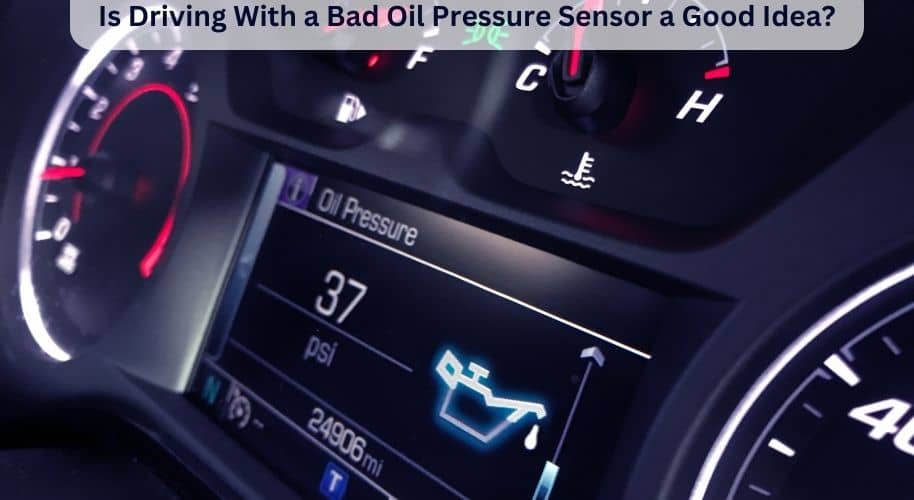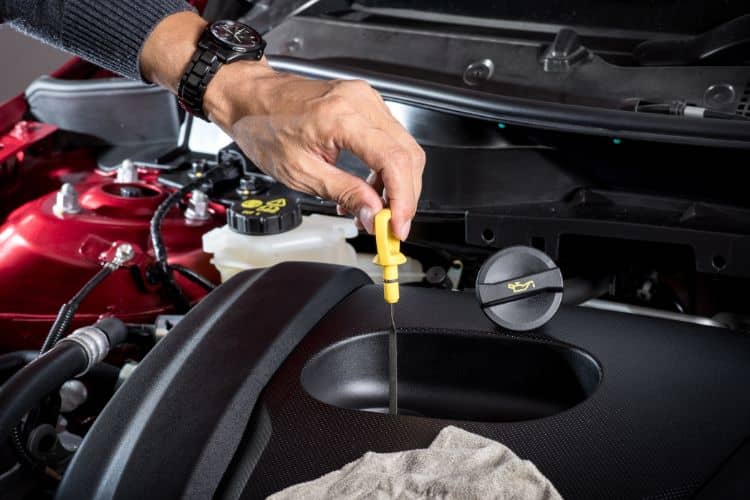Last Updated on March 14, 2023 by Henry T. Hawkins
Driving with a bad oil pressure sensor is not a good idea. It can be dangerous and should be avoided at all costs.
The oil pressure sensor (also known as an oil pressure sending unit) is a pressure transducer that measures the engine’s oil pressure. It sends these signals to the ECU and your oil pressure gauge or warning light.
So if it is malfunctioning, you may not be alerted to low oil pressure in your engine. Low oil pressure can cause serious damage to your engine, so it’s important to replace the sensor as soon as possible.
If you suspect that your oil pressure sensor is malfunctioning, there are a few signs you should look out for. These include an illuminated check engine light, flickering gauges, and unusual noises from the engine.
If any of these symptoms appear, it’s best to take your car to a mechanic for further inspection and repair.
We’ll dig deeper into the topic of bad oil pressure sensors in this article. So, keep reading!

What Is an Oil Pressure Sensor?
The oil pressure sensor acts as a monitor, keeping tabs on the amount of pressure your engine is under. This vital device actually consists of two distinct components – an oil pressure switch and an oil pressure sender – that work together to ensure optimal performance in all conditions.
For the engine to operate at optimum efficiency, the sensor transmits a signal to the engine control unit (ECU), which then changes the fuel delivery system and other components. A car’s overall performance and maintenance depend on the oil pressure sensor.
It is ensuring that the engine receives the proper amount of oil helps to keep it lubricated and running smoothly. To prevent any potential harm to your engine, replace your oil pressure sensor as soon as possible if it is not functioning properly.
Also read: Do racing steering wheels have airbags
Is Driving With a Bad Oil Pressure Sensor a Good Idea?
As stated above, No! If you continue to drive with this warning light on your dashboard, it may cause serious and permanent engine damage. Even though it can first look harmless, it’s wise to assume the worst until a professional mechanic has examined the problem for you.
A defective oil pressure sensor can cause your car to suffer from poor performance or, worse yet, an abrupt stall.
Additionally, this behaviour can create too much pressure on your engine, which could lead to expensive fixes in the future.
Regular maintenance can ensure safety and prevent any major issues from arising, so you won’t have to worry while driving.
You can ensure a long lifespan for your car by being careful about its maintenance and repair needs.
If you observe that your oil pressure gauge is out of the normal range, it’s critical to have your car serviced soon. To ensure that your car runs at its best, take action right away!
Also read: How to make your dashboard lights brighter
What are the Signs Of a Bad Oil Pressure Sensor?
There are a bunch of signs that indicate a malfunctioning oil pressure sensor. Typical indications of an oil pressure sensor malfunction include-
1. A false reading on the oil pressure metre on your car.
2. Your vehicle may signal that its oil pressure is low, so check the oil level soon.
3. A check engine light or illuminated oil pressure warning light flashing on the dashboard.
4. You’ll experience a decrease in fuel efficiency if you don’t take the necessary steps to keep your vehicle running at peak performance.
5. If you experience a decline in engine power combined with larger oil consumption, this indicates that something needs to be addressed.
6. Lastly, you might experience unusual engine noise and peculiar smells from the engine compartment.
If your vehicle exhibits any common signs, you must check the oil pressure as soon as possible.
Also read: Can a bad tensioner cause engine vibration
Reasons for Bad Oil Pressure Sensor
Due to various factors, oil pressure sensors can malfunction and fail, leading to incorrect readings or complete sensor failure. Common causes for bad oil pressure sensors include
1. Worn Bearings
An oil pressure sensor’s bearings may degrade over time, resulting in inaccurate readings or device failure. This is especially frequent in old, large vehicles.
2. Faulty Electrical Connectors
The oil pressure sensor may stop working if the wires connecting it to the wiring harness get corroded, loose, or damaged.
3. Clogged Oil Filter
Incorrect readings from the oil pressure sensor may result from an oil filter clogged with dirt or trash, which can lower engine pressure.
4. Dirty Engine Oil
Over time, engine oil can become contaminated with dirt or grime and lead to incorrect readings from the oil pressure sensor.
5. Low Oil Level
If an engine is low on oil, it can cause a decrease in pressure and prevent the oil pressure sensor from working properly.
Also read: Why did my jumper cables melt
How To Read An Oil Gauge?

When the car has been idling for about 20 minutes, you should notice that the pressure gauge needle comes to rest at its midpoint.
Any reading higher could mean that your oil pressure is too high due to a stuck or damaged relief valve, obstruction in the delivery lines, or some other issue.
To accurately measure the oil levels in your engine, follow these simple steps to read an oil gauge-
- The gauge is typically round and has a needle that shows the amount of oil by pointing left or right.
- Before getting an oil gauge measurement, start the engine and let it reach operating temperature.
- Locate the “Full” and “Low” marks on the gauge, which will be indicated by a line or triangle pointing to the left or right of centre respectively. The needle should always remain between these two markers when your vehicle is running.
- If the needle falls below the “Low” mark or above the “Full” mark, this indicates that you may have an issue with your oil system.
- Make sure your car is parked level before doing a regular oil level check. This will assure that the oil is spread equally and that your reading is exact.
- When adding more oil, use only the type of oil recommended by your vehicle’s manufacturer. Check the oil level once more using the oil gauge after adding oil to make sure it is within the allowed range.
How To Replace The Oil Pressure Sensor?
You can learn how to replace your vehicle’s Oil Pressure Sensor with these easy-to-follow instructions.
- Put on your safety glasses. Next, disconnect the negative battery cable to complete the process.
- To ensure safety, elevate and prop the car with a jack and support stands. Afterward, unplug the electrical connector from the oil pressure sensor.
- Loosen the sensor with a ratchet and an oil flow gauge socket for maximum efficiency.
- Examine the new and old oil pressure sensors to guarantee that they both share a similar design.
- Before installing the new oil pressure sensor, make sure to coat its threads with sealant.
- Next, securely attach the new oil pressure sensor to the engine using a torque wrench to ensure it is fastened according to the manufacturer’s guidelines.
- Securely attach the electrical connector for the oil pressure sensor and then attach the negative battery cable.
Follow this step-by-step process to efficiently replace your vehicle’s oil pressure sensor and get back on the road in no time.
FAQs
Lack of maintenance can cause the oil in the car to thin, trapping buildup from metal, dirt, and other particles. This corrosive material gradually erodes key engine components if not properly cared for. You must follow a maintenance schedule ideal for your vehicle to ensure your car’s greatest performance and longevity.
The oil in your car should be a cozy, pleasant shade of tan or caramel. This means that your car performs at its peak level and the oil is clean. You can tell everything is working well if this color doesn’t change.
When it comes to replacing your oil pressure sensor, it’s important to know the signs that indicate a bad sensor. The best way to test if your sensor is bad is through the lights on the oil pressure gauge.
If the low oil pressure warning light comes on when you start your car, this could be an indication that your oil pressure sensor needs to be replaced.
Other symptoms of a bad oil pressure sensor include incorrect readings on the oil pressure gauge, illuminated check engine lights and constant readings of either very high or absolute zero.
If you suspect that you have a bad oil pressure sensor, it’s best to take your car in for professional service as soon as possible. A loss of oil pressure can quickly result in engine failure, so it’s important to address any issues with the sensor right away.
The oil light on your dashboard doesn’t always mean you need new oil. Sometimes, it could indicate that your vehicle needs a new oil pressure sensor or pump replacement.
An oil pressure sensor can generally last anywhere from 30,000 to 150,000 miles depending on the type of vehicle and how well it is maintained.
However, you should keep up with regular oil changes to ensure that the oil pressure sensor continues to work properly.
A professional should be able to swiftly change your oil pressure sensor, with the total time depending upon your car’s engine and oil system layout. The task can usually take an hour or two at most.
To reset your oil pressure sensor, make sure you take the following steps:
Insert your key into the ignition and switch it to the “on” position, but don’t start up the engine.
Gently press the accelerator three times in succession within a span of 10 seconds, which should reset the system.
Confirm the reset by turning it off and then back on your ignition.
Wrapping Up
Thanks for reading! We hope this article has helped you understand the importance of a functioning oil pressure sensor in your car.
If you suspect any issues with your engine, it is best to take it to a professional mechanic right away and get it checked out.
Don’t take chances when it comes to your vehicle’s safety – it’s much better to be safe than sorry. Thanks again for reading!
Please share this article if you found it useful. Thanks!
Sources
- https://www.autozone.com/external-engine/oil-pressure-switch
- https://www.carparts.com/blog/the-top-3-signs-of-a-bad-oil-pressure-sensor/
- https://support.wellandpower.net/hc/en-us/articles/360002132118-What-is-an-Oil
